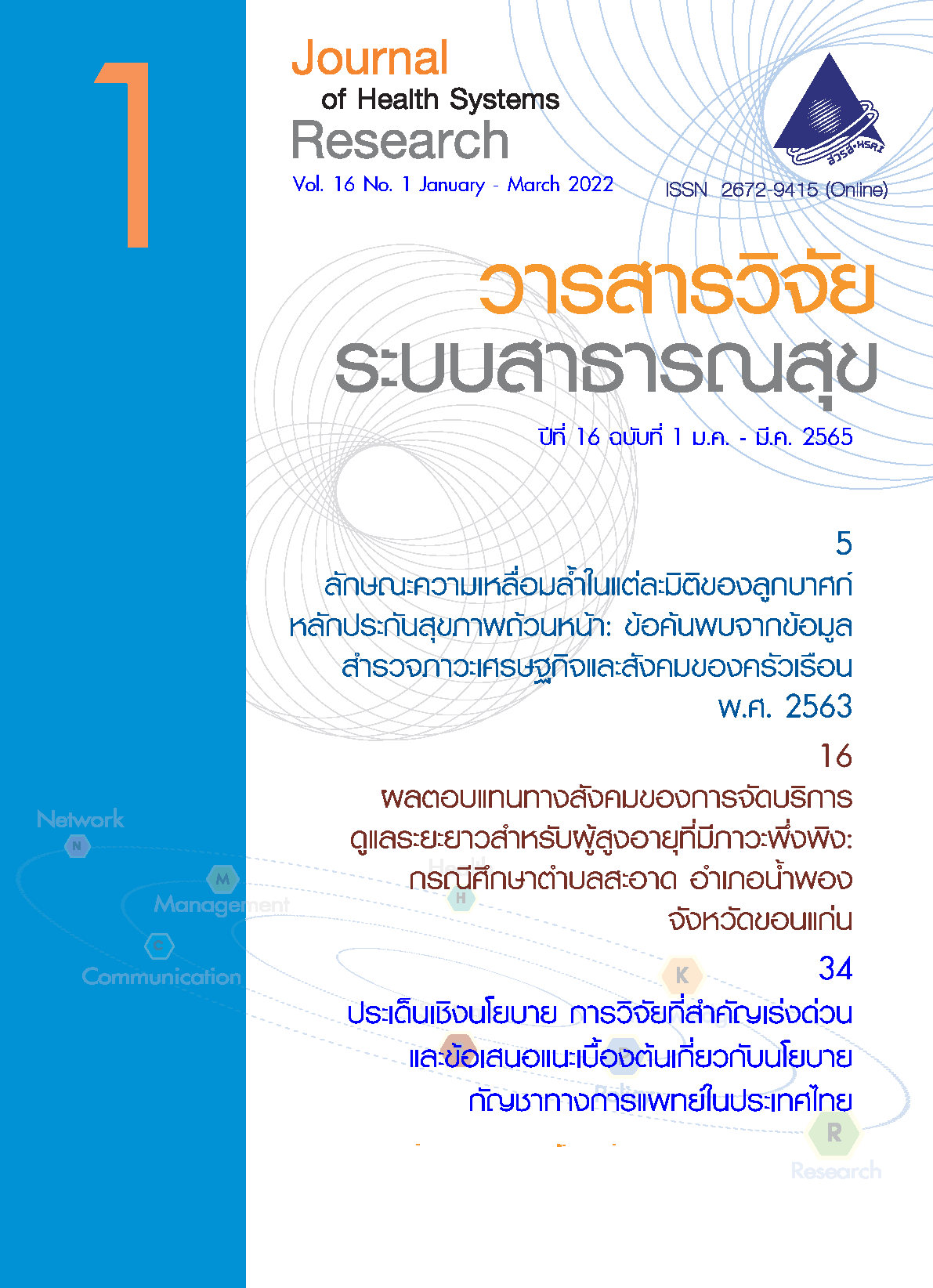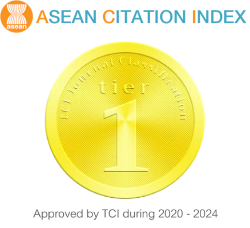ปัจจัยที่เกี่ยวข้องกับงานกับภาวะสุขภาพจิตของบุคลากรทางการแพทย์ในช่วงการแพร่ระบาดของไวรัสโคโรนา 2019
คำสำคัญ:
สุขภาพจิต, ไวรัสโคโรนา 2019, การระบาด, บุคลากรทางการแพทย์, ปัจจัยที่เกี่ยวข้องกับงานบทคัดย่อ
การวิจัยแบบตัดขวาง ณ จุดเวลาใดเวลาหนึ่งนี้ มีวัตถุประสงค์เพื่อศึกษาความชุกของภาวะสุขภาพจิต พฤติกรรมป้องกันเพื่อลดโอกาสติดเชื้อ และศึกษาความสัมพันธ์ระหว่างปัจจัยที่เกี่ยวข้องกับงานและภาวะสุขภาพจิตของบุคลากรทางการแพทย์สังกัดกระทรวงสาธารณสุขในช่วงแรกที่มีการระบาดของไวรัสโคโรนา 2019 เก็บข้อมูลด้วยแบบสอบถามออนไลน์ จำนวน 417 คน จาก 12 เขตสุขภาพ ระหว่างวันที่ 1-15 พฤษภาคม พ.ศ. 2563 ใช้แบบประเมิน Depress Anxiety Stress Scales (DASS-21) ฉบับภาษาไทยในการประเมินภาวะสุขภาพจิต ใช้สถิติไคสแควร์ในการวิเคราะห์ความสัมพันธ์ระหว่างปัจจัยและภาวะสุขภาพจิต ผลการศึกษาพบว่ากลุ่มตัวอย่างมีภาวะซึมเศร้า ภาวะวิตกกังวล ความเครียดอยู่ในระดับสูงถึงรุนแรง เท่ากับร้อยละ 2.4 ร้อยละ 7.2 และร้อยละ 3.9 ตามลำดับ การใส่หน้ากากอนามัยหรือหน้ากากผ้า (ร้อยละ 82.0) การล้างมือด้วยสบู่หรือเจลแอลกอฮอล์ (ร้อยละ 76.0) เป็นพฤติกรรมที่มีการปฏิบัติทุกครั้งสูงสุด ปัจจัยที่เกี่ยวข้องกับงานที่มีความสัมพันธ์กับภาวะสุขภาพจิตอย่างมีนัยสำคัญทางสถิติ ได้แก่ (1) การปฏิบัติงานใกล้ชิดกับผู้ติดเชื้อที่นอนรักษาตัวในโรงพยาบาล (2) ความพร้อมในการบริหารจัดการเพื่อลดความเสี่ยง (3) ความเพียงพอของอุปกรณ์ในการป้องกันตนเอง (4) ความกลัวการติดเชื้อจากการปฏิบัติงาน (5) ผู้ที่มารับบริการไม่ให้ความร่วมมือตามที่แนะนำ การศึกษานี้ชี้ให้เห็นว่า การมีแนวทางการบริหารจัดการที่มีประสิทธิผลเพื่อลดการติดเชื้อเป็นปัจจัยที่สัมพันธ์และสามารถปรับเปลี่ยนได้ สำหรับการป้องกันปัญหาสุขภาพจิตของบุคลากรทางการแพทย์ โดยเฉพาะอย่างยิ่งในผู้ที่สัมผัสใกล้ชิดโดยตรงกับผู้ป่วยที่นอนพักรักษาตัวในโรงพยาบาลจากการระบาด “ระลอกใหม่” หรือ “การระบาดซ้ำ” ของไวรัสโคโรนา 2019
เอกสารอ้างอิง
World Health Organization. Coronavirus disease (COVID-19) outbreak: coronavirus disease (COVID-19) pandemic [Internet]. 2020 [cited 2020 Oct 17]. Available from: https://www.euro.who.int/en/health-topics/health-emergencies/coronavirus-covid-19/novel-coronavirus-2019-ncov.
Blumenthal D, Fowler EJ, Abrams M, Collins SR. Covid-19 — implications for the health care system. N Engl J Med. 2020;383(15):1483–8.
Gai R, Tobe M. Managing healthcare delivery system to fight the COVID-19 epidemic: experience in Japan. Glob Health Res Policy. 2020;5(1):23.
Centers for Disease Control and Prevention. Healthcare facilities: managing operations during the COVID-19 pandemic [Internet]. 2020 [cited 2020 Oct 17]. Available from: https://www.cdc.gov/coronavirus/2019-ncov/hcp/guidance-hcf.html.
Han E, Tan MMJ, Turk E, Sridhar D, Leung GM, Shibuya K, et al. Lessons learnt from easing COVID-19 restrictions: an analysis of countries and regions in Asia Pacific and Europe. Lancet. 2020;396(10261):1525-34.
Krist AH, DeVoe JE, Cheng A, Ehrlich T, Jones SM. Redesigning primary care to address the covid-19 pandemic in the midst of the pandemic. Ann Fam Med. 2020;18(4):349–54.
Lai J, Ma S, Wang Y, Cai Z, Hu J, Wei N, et al. Factors associated with mental health outcomes among health care workers exposed to coronavirus disease 2019. JAMA Netw. Open. 2020;3(3):e203976.
Nguyen LH, Drew DA, Graham MS, Joshi AD, Guo C-G, Ma W, et al. Risk of COVID-19 among front-line health-care workers and the general community: a prospective cohort study. Lancet Public Health. 2020;5(9):e475-83.
Pappa S, Ntella V, Giannakas T, Giannakoulis VG, Papoutsi E, Katsaounou P. Prevalence of depression, anxiety, and insomnia among healthcare workers during the COVID-19 pandemic: a systematic review and meta-analysis. Brain Behav Immun. 2020;88:901-7.
da Silva FCT, Neto MLR. Psychological effects caused by the COVID-19 pandemic in health professionals: a systematic review with meta-analysis. Prog Neuropsychopharmacol Biol Psychiatry. 2021;104:110062.
Muller AE, Hafstad EV, Himmels JPW, Smedslund G, Flottorp S, Stensland SØ, et al. The mental health impact of the covid-19 pandemic on healthcare workers, and interventions to help them: a rapid systematic review. Psychiatry Res. 2020;293:113441.
Spoorthy MS, Pratapa SK, Mahant S. Mental health problems faced by healthcare workers due to the COVID-19 pandemic–a review. Asian J Psychiatr. 2020;51:102119.
Wayne W. D. Biostatistics: a foundation of analysis in the health sciences. 6th ed. John Wiley&Sons; 1995.
Ngamjarus C, Chongsuvivatwong V. n4Studies: sample size calculation for an epidemiological study on a smart device. Siriraj Med J. 2016;68(3):160-70.
Strategy and Planning Division, Ministry of Public Health. Report health resource [Internet]. 2018 [cited 2020 Apr 1]. Available from: http://bps.moph.go.th/new_bps/sites/default/files/Report%20Health%20Resource%202018.pdf.
Thongkaeo T, Suppapitiporn S. Stress in workplace and its related factors among registered nurse at outpatient department of a hospital in Bangkok. Chula Med J. 2018;62(2):197-209. (in Thai)
Oei TPS, Sawang S, Goh YW, Mukhtar F. Using the depression anxiety stress scale 21 (DASS-21) across cultures. Int J Psychol. 2013;48(6):1018-29.
Giorgi G, Lecca LI, Alessio F, Finstad GL, Bondanini G, Lulli LG, et al. COVID-19-related mental health effects in the workplace: a narrative review. Int J Environ Res Public Health. 2020;17(21):7857.
Tantrakarnapa K, Bhopdhornangkul B, Nakhaapakorn K. Influencing factors of COVID-19 spreading: a case study of Thailand. Z Gesundh Wiss. 2020;1-7.
Evanoff BA, Strickland JR, Dale AM, Hayibor L, Page E, Duncan JG, et al. Work-related and personal factors associated with mental well-being during the covid-19 response: survey of health care and other workers. J Med Internet Res. 2020;22(8):e21366.
Thitaree K, Chaiwong W. A study on prevalence of work-related stress and relating factors among staff in a private hospital. TMJ. 2019;19(1):115-32. (in Thai)
Karasek RA. Job demands, job decision latitude, and mental strain: implications for job redesign. Adm Sci Q. 1979;24(2):285–308.
Simms A, Fear NT, Greenberg N. The impact of having inadequate safety equipment on mental health. Occup Med. 2020;70(4):278-81.
Karasek R. Demand/Control model: a social, emotional, and physiological approach to stress risk and active behaviour development. In: Encyclopaedia of occupational health and safety. Geneva: International Labour Organization; 1998. p. 34.6-34.14.
ดาวน์โหลด
เผยแพร่แล้ว
รูปแบบการอ้างอิง
ฉบับ
ประเภทบทความ
สัญญาอนุญาต

อนุญาตภายใต้เงื่อนไข Creative Commons Attribution-NonCommercial-NoDerivatives 4.0 International License.
วารสารวิจัยระบบสาธารณสุขอยู่ภายใต้การอนุญาต Creative Commons Attribution-NonCommercial-NoDerivatives 4.0 International (CC BY-NC-ND 4.0) เว้นแต่จะระบุไว้เป็นอย่างอื่น




